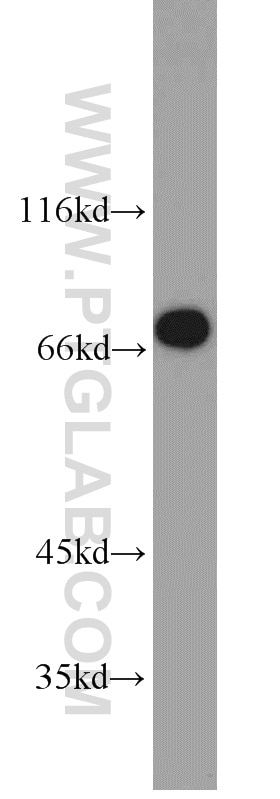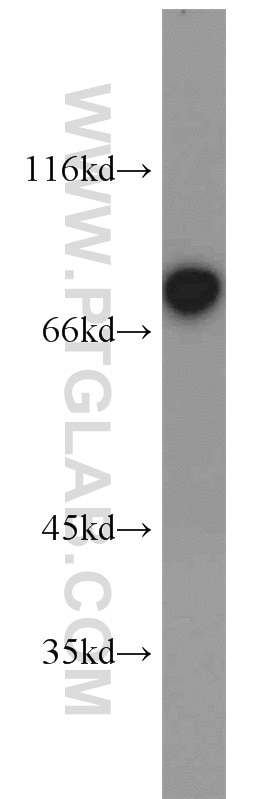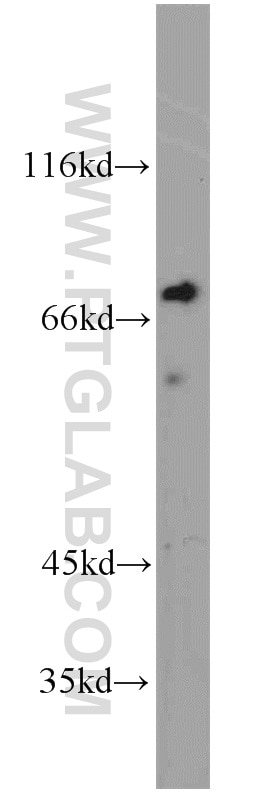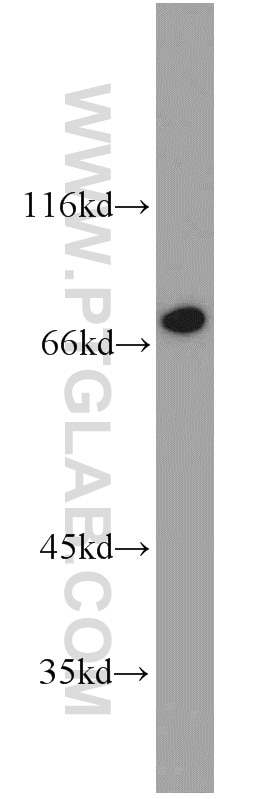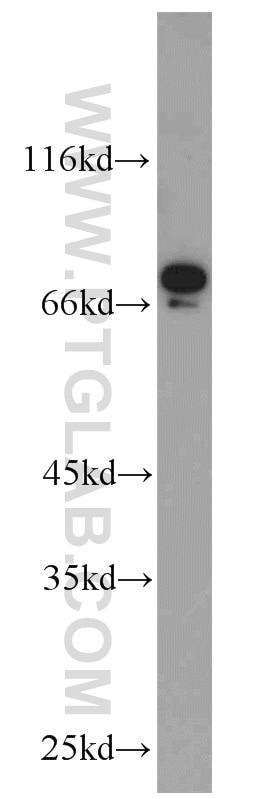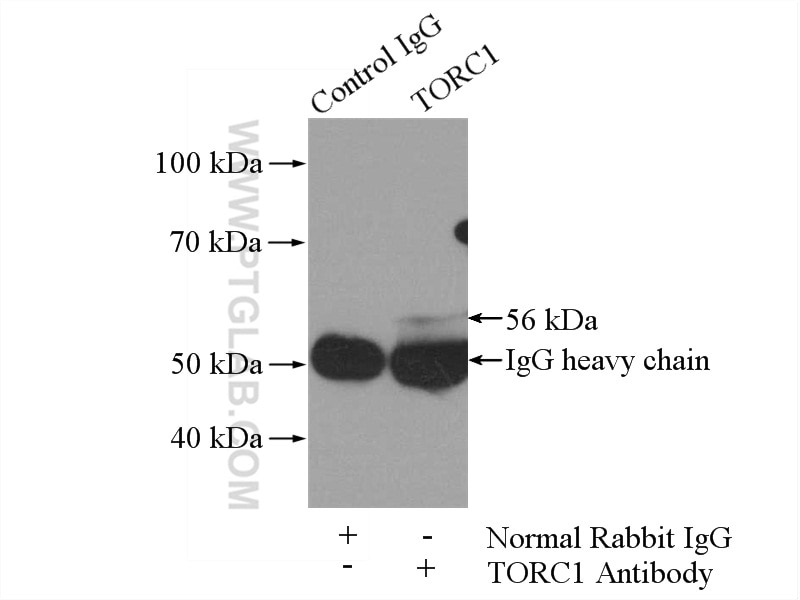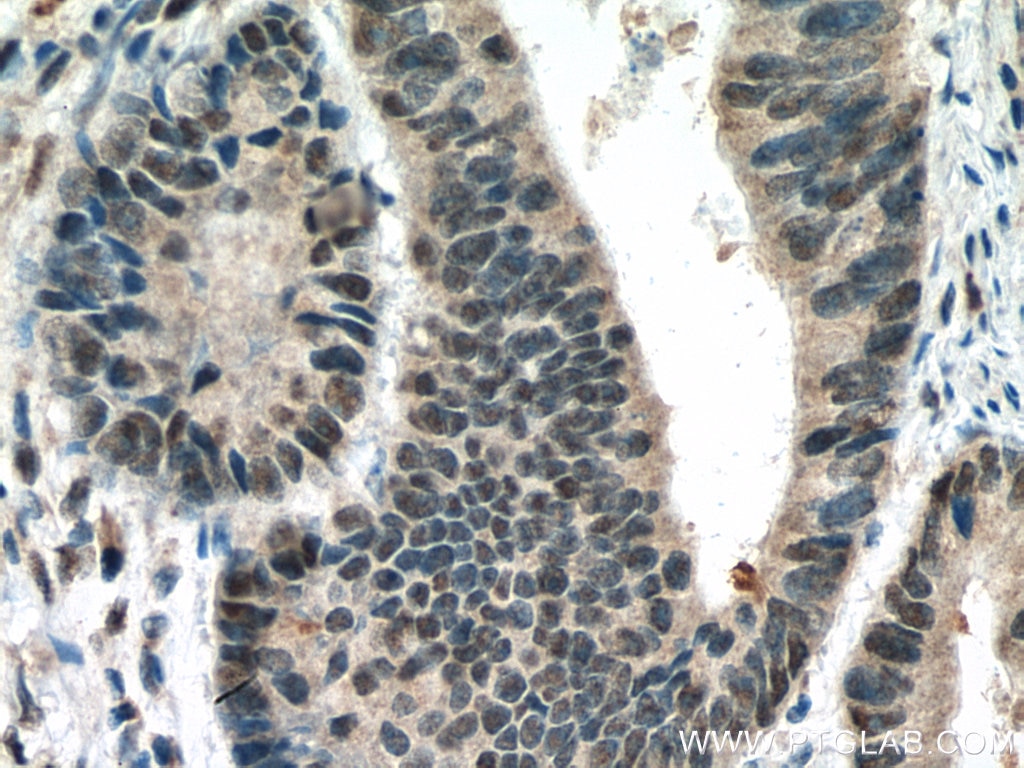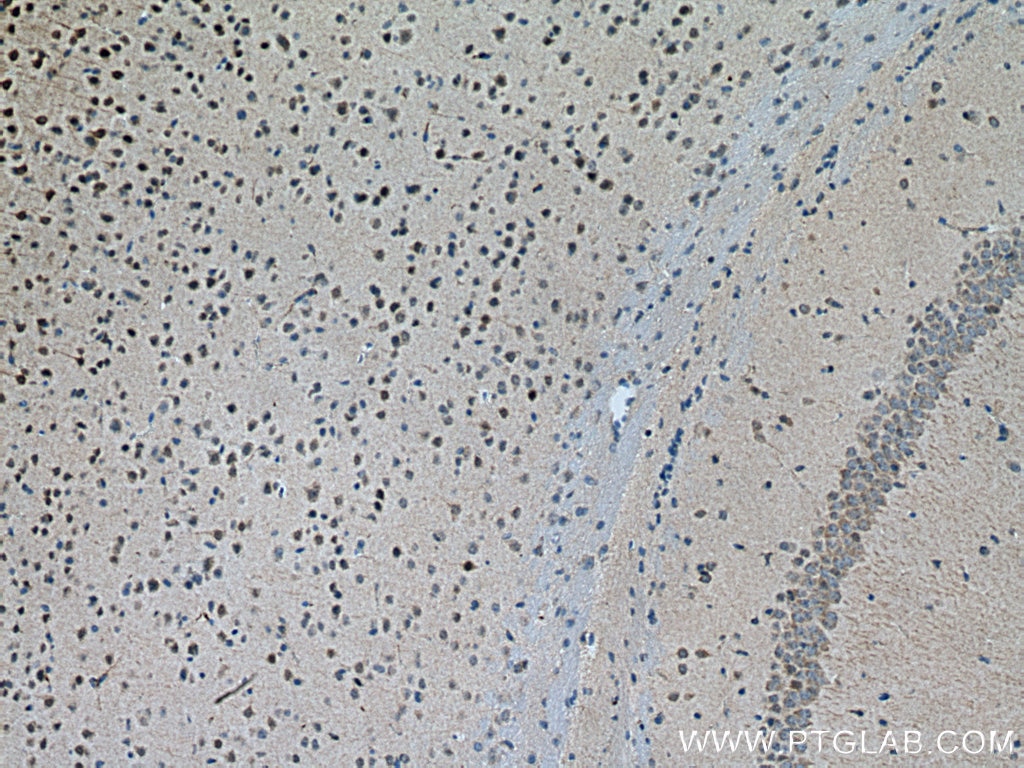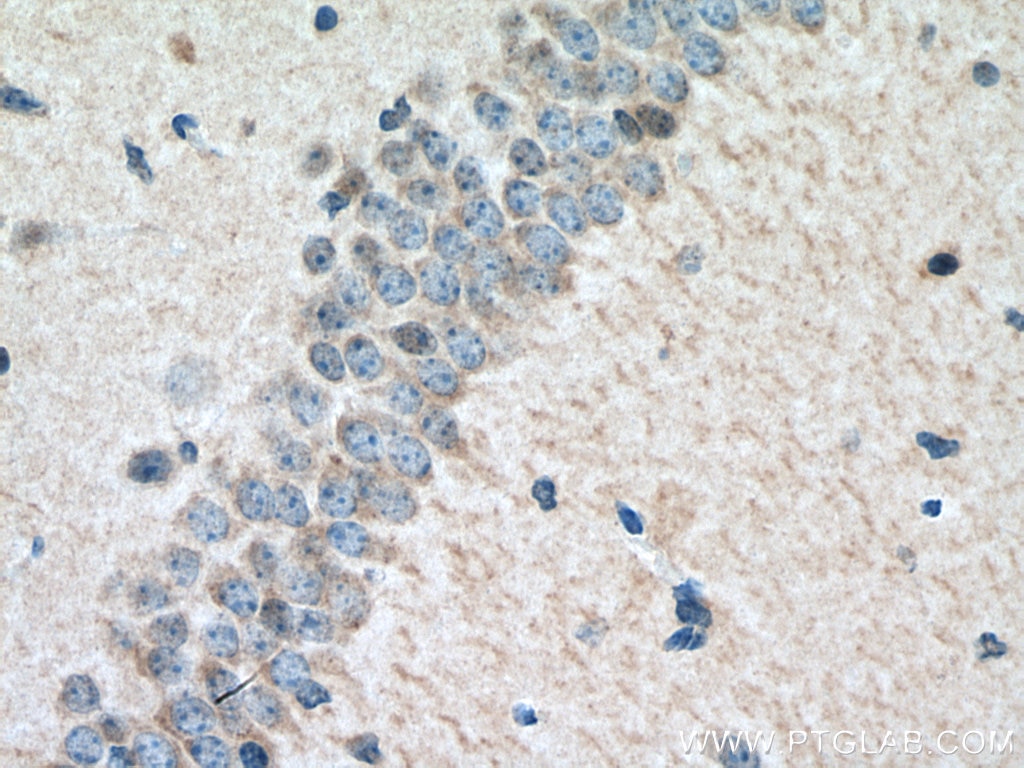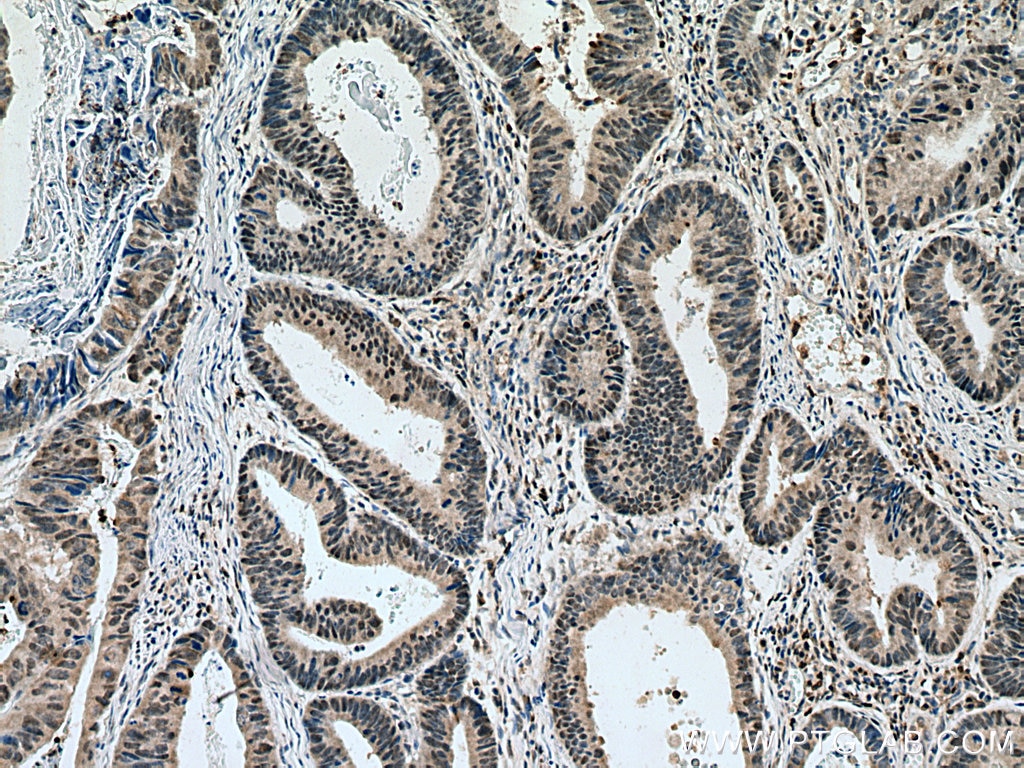Validation Data Gallery
Tested Applications
| Positive WB detected in | mouse kidney tissue, A431 cells, Jurkat cells, L02 cells, mouse brain tissue |
| Positive IP detected in | mouse kidney tissue |
| Positive IHC detected in | human colon cancer tissue, mouse brain tissue Note: suggested antigen retrieval with TE buffer pH 9.0; (*) Alternatively, antigen retrieval may be performed with citrate buffer pH 6.0 |
Recommended dilution
| Application | Dilution |
|---|---|
| Western Blot (WB) | WB : 1:500-1:1000 |
| Immunoprecipitation (IP) | IP : 0.5-4.0 ug for 1.0-3.0 mg of total protein lysate |
| Immunohistochemistry (IHC) | IHC : 1:50-1:500 |
| It is recommended that this reagent should be titrated in each testing system to obtain optimal results. | |
| Sample-dependent, Check data in validation data gallery. | |
Published Applications
| KD/KO | See 1 publications below |
| WB | See 9 publications below |
| IHC | See 1 publications below |
| IF | See 3 publications below |
| IP | See 1 publications below |
Product Information
10441-1-AP targets TORC1/CRTC1 in WB, IHC, IF, IP, ELISA applications and shows reactivity with human, mouse samples.
| Tested Reactivity | human, mouse |
| Cited Reactivity | human, mouse, rat |
| Host / Isotype | Rabbit / IgG |
| Class | Polyclonal |
| Type | Antibody |
| Immunogen |
CatNo: Ag0693 Product name: Recombinant human TORC1 protein Source: e coli.-derived, PGEX-4T Tag: GST Domain: 1-300 aa of BC028050 Sequence: MATSNNPRKFSEKIALHNQKQAEETAAFEEVMKDLSLTRAARLQLQKSQYLQLGPSRGQYYGGSLPNVNQIGSGTMDLPFQTPFQSSGLDTSRTTRHHGLVDRVYRERGRLGSPHRRPLSVDKHGRQADSCPYGTMYLSPPADTSWRRTNSDSALHQSTMTPTQPESFSSGSQDVHQKRVLLLTVPGMEETTSEADKNLSKQAWDTKKTGSRPKSCEVPGINIFPSADQENTTALIPATHNTGGSLPDLTNIHFPSPLPTPLDPEEPTFPALSSSSSTGNLAANLTHLGIGGAGQGMSTP 相同性解析による交差性が予測される生物種 |
| Full Name | CREB regulated transcription coactivator 1 |
| Calculated molecular weight | 75 kDa |
| Observed molecular weight | 68-80 kDa |
| GenBank accession number | BC028050 |
| Gene Symbol | CRTC1 |
| Gene ID (NCBI) | 23373 |
| RRID | AB_2083835 |
| Conjugate | Unconjugated |
| Form | |
| Form | Liquid |
| Purification Method | Antigen affinity purification |
| UNIPROT ID | Q6UUV9 |
| Storage Buffer | PBS with 0.02% sodium azide and 50% glycerol{{ptg:BufferTemp}}7.3 |
| Storage Conditions | Store at -20°C. Stable for one year after shipment. Aliquoting is unnecessary for -20oC storage. |
Background Information
CRTC1, also named as MECT1,TORC1, and WAMTP1, belongs to the TORC family. It is a transcriptional coactivator for CREB1 which activates transcription through both consensus and variant cAMP response element (CRE) sites. CRTC1 acts as a coactivator, in the SIK/TORC signaling pathway, being active when dephosphorylated and acts independently of CREB1 'Ser-133' phosphorylation. It enhances the interaction of CREB1 with TAF4. CRTC1 regulates the expression of specific CREB-activated genes such as the steroidogenic gene, StAR. It is a potent coactivator of PGC1alpha and inducer of mitochondrial biogenesis in muscle cells. CRTC1 is also a coactivator for TAX activation of the human T-cell leukemia virus type 1 (HTLV-1) long terminal repeats (LTR). In the hippocampus, CRTC1 involved in late-phase long-term potentiation (L-LTP) maintenance at the Schaffer collateral-CA1 synapses. It may be required for dendritic growth of developing cortical neurons. This is a rabbit polyclonal antibody raised against residues near N terminus of human CRTC1. CRTC1 has some isoforms produced by alternative splicing with MW of 67 kDa, 68 kDa and 62 kDa. Sometimes it appears as a 75-80 kDa band probably due to phosphorylation (PMID: 17183642; 22770221)
Protocols
| Product Specific Protocols | |
|---|---|
| IHC protocol for TORC1/CRTC1 antibody 10441-1-AP | Download protocol |
| IP protocol for TORC1/CRTC1 antibody 10441-1-AP | Download protocol |
| WB protocol for TORC1/CRTC1 antibody 10441-1-AP | Download protocol |
| Standard Protocols | |
|---|---|
| Click here to view our Standard Protocols |
Publications
| Species | Application | Title |
|---|---|---|
Nat Cell Biol Eosinophil extracellular traps drive asthma progression through neuro-immune signals.
| ||
iScience Neural and central mechanisms of kidney fibrosis after relief of ureteral obstruction | ||
J Ethnopharmacol Exploring the potential mechanism of Heng-Gu-Gu-Shang-Yu-He-Ji therapy for osteoporosis based on network pharmacology and transcriptomics | ||
Sci Rep Targeted Metabolomics Reveals Abnormal Hepatic Energy Metabolism by Depletion of β-Carotene Oxygenase 2 in Mice. | ||
J Agric Food Chem Fluoride Stimulates Anxiety- and Depression-like Behaviors Associated with SIK2-CRTC1 Signaling Dysfunction. |

